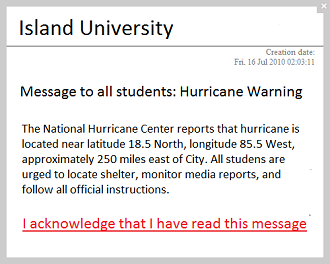No matter how advanced your business facilities and tools are or how careful your organization is in taking precautions, you still will not be spared from disasters and situations that can disrupt your operations. Fortunately, there continue to be improvements and developments in the field of crisis management, such as various types of alert software. Despite these developments, effective communication still remains as a top challenge, as evidenced by post-disaster evaluations.
Obviously, communication is critical not only during times of emergencies but also in everyday operations. From communicating with IT about escalation issues to connecting with customers and the other stakeholders of the organization, proper and effective communication is a must.
Alert Software for Business Continuity
Crisis time is crunch time; as a business leader, you need to inform your stakeholders about the nature of the situation. Doing this requires the use of mass notification systems and alert software to deliver your message, be it about reporting IT incidents, alerting suppliers, informing employees or notifying contractors, visitors and guests. Of course the alert software you choose must allow you to send a message to your intended recipients at once so they could respond to your alert and act accordingly.
Businesses are transforming rapidly, in answer to the times. Now there are more mobile employees, some even working in different parts of the world. This makes delivering alert messages even more complicated and difficult. Interruptions can come in any form – power outages, inclement weather, terrorist attacks – and the location difference can sometimes add to the pressure and the difficulty in reaching key people you need during a crisis.
Fortunately, many types of alert software have been introduced more than a decade ago, and thanks to technology, these applications just keep getting better and better. But more than just the software, what is important is how it is implemented and used to make communication – especially during a crisis – even more effective.
Communicating during Crisis
Alert systems are very helpful, but what you must remember is that they only serve as tools to communicate. Merely having a notification system in place does not guarantee that you will be able to properly communicate what is needed for your organization to survive disasters that may come. Therefore, you must have a comprehensive communication strategy that includes a carefully crafted disaster preparedness plan. Here are some tips you can use in developing and implementing your plan:
1. Choose a representative. Select a well-trained individual who will be the point of contact and will deliver the message to the necessary parties.
2. Identify authorized personnel. Not everyone could go and make alerts, especially during a crisis. Determine which of your staff should be given the authority to release alert messages for various situations.
3. Set and hold training for your leaders. Your spokespersons need to be trained about what to do in times of crisis. They should know when and how alerts should be released to get the best outcomes.
4. Keep your messages on target. Develop key messages that have your organization values tucked in. This will help you focus your messages.
5. Establish guidelines and protocols. Deciding on the fly during crises can result in disastrous outcomes, so make sure your alert processes are guided.
6. Update your contact list. Make regular updates about the people who are supposed to receive your alerts to make sure you do not miss anyone.
7. Communicating internally first. Before taking the information to other stakeholders, make sure all your internal customers are in the know.
8. Be prepared with alert messages. Draft messages beforehand, taking into consideration how they would be received and acted upon.
9. Familiarize your organization with your alert software. Use your system for other business processes: IT notifications, policy updates and other forms of internal communication.
10. Let the public know. Before anyone else leaks the info outside, make sure you have prepared messages to release to the public.
Communicating in a crisis need not be difficult; by deploying an emergency notification system and following the above mentioned tips, you will be able to manage it.






